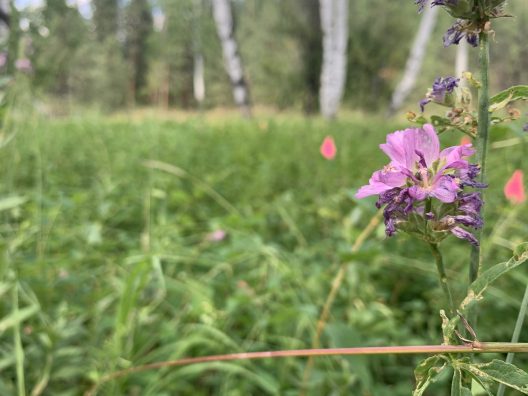Restoring Habitat for Species Recovery

Five years ago, Rare Care established vegetation plots in a population of Wenatchee Mountains checker-mallow (Sidalcea oregana var. calva) to evaluate how to control the spread of shrubs and non-native grasses in its habitat. This federally endangered plant grows in flat, seasonally wet meadows in Ponderosa pine, Douglas fir, or aspen forest openings, and is known from only two large and two very small extant populations in the Wenatchee Mountains. The largest population is at Camas Meadows Natural Area Preserve with about 40,000 plants, and the second largest, with approximately 3,000 plants, inhabits the expansive front yard of the privately owned lodge near Leavenworth. This second population is the focus of our study.
At our study site, the checker-mallow is threatened by non-native pasture grasses and the expansion of shrubs into its habitat. Historically, under management by Indigenous groups, frequent, low-intensity fires prevented trees and shrubs from establishing in the checker-mallow’s meadow habitat. Fire suppression after European colonization has allowed shrubs to become more abundant in the meadow, competing with the checker-mallow for light, water, and nutrients. In addition, European settlers planted non-native grasses for livestock forage that are pushing out native vegetation in the meadow, including the checker-mallow. The absence of recurring fire is detrimental to the checker-mallow: its seeds germinate more readily when they are exposed to hot temperatures during a wildfire.
To learn how to best reduce shrub and nonnative grass competition and increase the number and vigor of checker-mallow plants, Rare Care established test plots to evaluate different vegetation treatments. We installed 24 plots to test four vegetation treatments: spring mowing, a prescribed burn, raking in combination with herbicide carefully applied to shrubs or grasses, and a control treatment where no action was taken. We also wanted to test if spreading extra checker-mallow seeds would increase the number of seedlings; therefore, in each plot we set up two smaller plots and added checker-mallow seeds to one, leaving the other unseeded. We returned every summer to monitor how the plant community and checker-mallow responded to the treatments.
After five years, we learned that adding checker-mallow seeds increased the number of new seedlings in all plots across all vegetation treatments, suggesting that growth of wild population might be limited by inadequate seed supply. Our raking treatment helped promote the growth of wildflowers, and our herbicide and mowing treatments reduced the shrubs and wildflowers in the meadow the spring after treatment. However, no treatment had a lasting impact beyond the first year, and none of the treatments showed a positive or negative effect on established checker-mallow plants. We were surprised to find fire didn’t seem to affect the vegetation. We suspect this was because our prescribed burn was not hot enough to have a lasting impact on vegetation.
It is well established that restoring natural areas is an ongoing process that occurs over many years. Other studies with similar goals to ours have shown treatments are more successful when different types of treatment are combined or treatments are repeated more than once. Over the next three years, Rare Care plans to repeat some of the treatments and test different combinations together. We hope to identify the most effective techniques for controlling the spread of shrubs and non-native grasses at this population with the long-term goal of expanding the population’s size and extent.